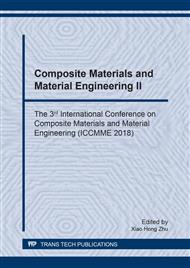[1]
Y. A. Alhamed, S. U. Rather, A. H. El-Shazly, S. F. Zaman, M. A. Daous, and A. A. Al-Zahrani, Preparation of activated carbon from fly ash and its application for CO2 capture,, Korean Journal of Chemical Engineering, vol. 32, pp.723-730, (2015).
DOI: 10.1007/s11814-014-0273-2
Google Scholar
[2]
A. M. M. Abdelhaleem, M. Y. Abdellah, H. I. Fathi, and M. Dewidar. Mechanical Properties of ABS Embedded with Basalt Fiber Fillers, Journal for Manufacturing Science and Production, vol. 16, no. 2, pp.69-74, (2016).
DOI: 10.1515/jmsp-2016-0006
Google Scholar
[3]
W. P. F. Neto, H. A. Silv´erio, N. O. Dantas, and D. Pasquini, Extraction and characterization of cellulose nanocrystals from agro-industrial residue-soy hulls,, Industrial Crops and Products, vol. 42, pp.480-488, (2013).
DOI: 10.1016/j.indcrop.2012.06.041
Google Scholar
[4]
H. S. Shokry, M. F. Elkady, A. A. Farghali, A. M. Salem, and AI. Abd.El-Hamid, Fabrication of novel magnetic zinc oxide cellulose acetate hybrid nano-fiber to be utilized for phenol decontamination,, Journal of the Taiwan Institute of Chemical Engineers, vol. 78, pp.307-316, (2017).
DOI: 10.1016/j.jtice.2017.06.021
Google Scholar
[5]
S. Elanthikkal, U. Gopalakrishnapanicker, S. Varghese, and J. T. Guthrie, Cellulose microfibers produced from banana plant wastes: Isolation and characterization,, Carbohydrate Polymers, vol. 80, no. 3, pp.852-859, (2010).
DOI: 10.1016/j.carbpol.2009.12.043
Google Scholar
[6]
R. Li, J. Fei, Y. Cai, Y. Li, J. Feng, and J. Yao, Cellulose whiskers extracted from mulberry: A novel biomass production,, Carbohydrate Polymers, vol. 76, no. 1, pp.94-99, (2009).
DOI: 10.1016/j.carbpol.2008.09.034
Google Scholar
[7]
Q. Li and S. Renneckar, Supramolecular structure characterization of molecularly thin cellulose i nanoparticles," Biomacromolecules, vol. 12, no. 3, p.650,659, (2011).
DOI: 10.1021/bm101315y
Google Scholar
[8]
X. Cao, Y. Habibi, and L. A. Lucia, One-pot polymerization, surface grafting, and processing of waterborne polyurethanecellulose nanocrystal nanocomposites,, Journal of Materials Chemistry, vol. 19, no. 38, pp.7137-7145, (2009).
DOI: 10.1039/b910517d
Google Scholar
[9]
M. Roohani, Y. Habibi, N. M. Belgacem, G. Ebrahim, A. N. Karimi, and A. Dufresne, Cellulose whiskers reinforced polyvinyl alcohol copolymers nanocomposites,, European polymer journal, vol. 44, no. 8, pp.2489-2498, (2008).
DOI: 10.1016/j.eurpolymj.2008.05.024
Google Scholar
[10]
W. L. E. Magalhaes, X. Cao, and L. A. Lucia, Cellulose nanocrystals/cellulose core-in-shell nanocomposite assemblies,, Langmuir, vol. 25, no. 22, pp.13250-13257, (2009).
DOI: 10.1021/la901928j
Google Scholar
[11]
M. S. Peresin, Y. Habibi, J. O. Zoppe, J. J. Pawlak, and O. J. Rojas, Nanofiber composites of polyvinyl alcohol and cellulose nanocrystals: manufacture and characterization,, Biomacromolecules, vol. 11, no. 3, pp.674-681, (2010).
DOI: 10.1021/bm901254n
Google Scholar
[12]
H. Qi, J. Cai, L. Zhang, and S. Kuga, Properties of films composed of cellulose nanowhiskers and a cellulose matrix regenerated from alkali/urea solution,,Biomacromolecules, vol. 10, no. 6, pp.1597-1602, (2009).
DOI: 10.1021/bm9001975
Google Scholar
[13]
J. Cai, L. Zhang, J. Zhou, H. Li, H. Chen, and H. Jin, Novel fibers prepared from cellulose in naoh/urea aqueous solution,, Macromolecular Rapid Communications, vol. 25, no. 17, pp.1558-1562, (2004).
DOI: 10.1002/marc.200400172
Google Scholar
[14]
A. Bhatnagar and M. Sain, Processing of cellulose nanofiber-reinforced composites,, Journal of Reinforced Plastics and Composites, vol. 24, no. 12, pp.1259-1268, (2005).
DOI: 10.1177/0731684405049864
Google Scholar
[15]
M. Z. Rong, M. Q. Zhang, Y. Liu, G. C. Yang, and H. M. Zeng, The effect of fiber treatment on the mechanical properties of unidirectional sisal-reinforced epoxy composites,, Composites Science and technology, vol. 61, no. 10, pp.1437-1447, (2001).
DOI: 10.1016/s0266-3538(01)00046-x
Google Scholar
[16]
N. Johar, I. Ahmad, and A. Dufresne, Extraction, preparation and characterization of cellulose fibers and nanocrystals from rice husk,, Industrial Crops and Products, vol. 37, no. 1, pp.93-99, (2012).
DOI: 10.1016/j.indcrop.2011.12.016
Google Scholar
[17]
S. E. Elhafez, H. A. Hamad, A. A. Zaatout, and G. F. Malash. Management of agricultural waste for removal of heavy metals from aqueous solution: adsorption behaviors, adsorption mechanisms, environmental protection, and techno-economic analysis,, Environmental Science and Pollution Research, vol. 24, no. 2, pp.1398-1415, (2017).
DOI: 10.1007/s11356-016-7891-7
Google Scholar


